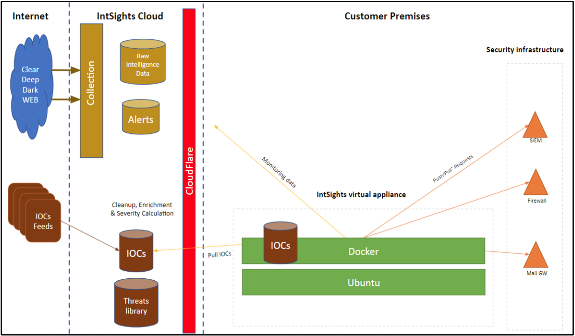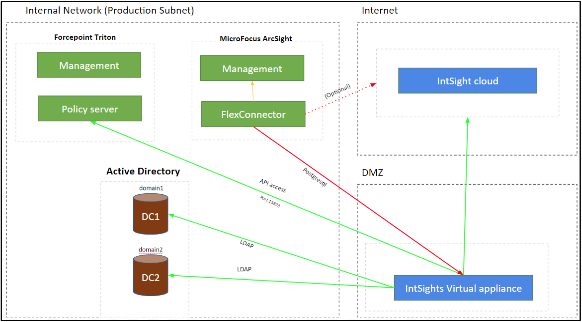The Threat Command Virtual Appliance | Threat Command Documentation
The following diagrams illustrate how the virtual appliance fits in your company environment.

High-level connectivity diagram

High-level Device connectivity
Virtual appliance hardening is detailed in Virtual Appliance Hardening.
General prerequisites for deploying the appliance
For on-premises security devices, you must set up the Threat Command virtual appliance (“appliance”) on either a VMware or Hyper-V host. For cloud devices, skip to Device-side Configuration for Cloud Devices.
Prerequisites
- Subscription to the Threat Command TIP and Automation modules
If you don’t have such a subscription, contact Rapid7 sales. - Network connectivity from the appliance to the Threat Command cloud (External)
There is no connectivity initiated from the cloud to the internal network.
Connectivity includes unrestricted access to *.intsights.com- To enable access based on the IP addresses, enable the IPv4 addresses listed here: https://www.cloudflare.com/ips/
(Threat Command uses Cloudflare for IP address allocation.)
- To enable access based on the IP addresses, enable the IPv4 addresses listed here: https://www.cloudflare.com/ips/
- For appliance versions earlier than v3.7.0, unrestricted access is also required to: *.gcr.io, *.googleapis.com, *.docker.io, *.cloudfront.net
- Network connectivity between the appliance to and from the security devices for IOC sharing.
| Service/Port | Direction | Purpose |
|---|---|---|
| DNS (53/UDP) | Outgoing (from the machine) | Allow DNS queries from the machine. |
| HTTPS (443/TCP) | Incoming (to the machine) | From the internal network to the virtual appliance “Management” interface, for administration. |
| HTTPS (443/TCP) | Outgoing (from the machine) | From the virtual appliance to Threat Command cloud (Internet). Please make sure that all access is allowed to: *.intsights.com That is, all subdomains under the above domain must be allowlisted too. Note: during the initial setup phase of the DEB file, the machine needs to have unrestricted access to the internet. After a successful installation, the access can be limited to the above. |
| SSH (22/TCP or other) | Incoming (to the machine) | From the internal network to the virtual appliance for administration. |
| 8080/TCP | Incoming (to the machine) | From the various security devices to the virtual appliance for pulling IOCs. |
| Per device connectivity, (as described inIntegration support list) | Outgoing (from the machine) | From the virtual appliance to the various security devices, for pushing IOCs. |